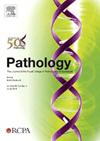基于深度学习的原发性全切片图像肾细胞癌患者诊断与生存预测
IF 3.6
3区 医学
Q1 PATHOLOGY
引用次数: 0
摘要
探索肾细胞癌(RCC)的新型诊断和预后生物标志物仍然是临床的迫切需求。我们提出了基于深度学习的人工智能策略。研究包括来自多个中心的1752张全切片图像。本文章由计算机程序翻译,如有差异,请以英文原文为准。
Deep learning-based diagnosis and survival prediction of patients with renal cell carcinoma from primary whole slide images
There is an urgent clinical demand to explore novel diagnostic and prognostic biomarkers for renal cell carcinoma (RCC). We proposed deep learning-based artificial intelligence strategies. The study included 1752 whole slide images from multiple centres.
Based on the pixel-level of RCC segmentation, the diagnosis diagnostic model achieved an area under the receiver operating characteristic curve (AUC) of 0.977 (95% CI 0.969–0.984) in the external validation cohort. In addition, our diagnostic model exhibited excellent performance in the differential diagnosis of RCC from renal oncocytoma, which achieved an AUC of 0.951 (0.922–0.972). The graderisk for the recognition of high-grade tumour achieved AUCs of 0.840 (0.805–0.871) in the Cancer Genome Atlas (TCGA) cohort, 0.857 (0.813–0.894) in the Shanghai General Hospital (General) cohort, and 0.894 (0.842–0.933) in the Clinical Proteomic Tumor Analysis Consortium (CPTAC) cohort, for the recognition of high-grade tumour. The OSrisk for predicting 5-year survival status achieved an AUC of 0.784 (0.746–0.819) in the TCGA cohort, which was further verified in the independent general cohort and the CPTAC cohort, with AUCs of 0.774 (0.723–0.820) and 0.702 (0.632–0.765), respectively. Moreover, the competing-risk nomogram (CRN) showed its potential to be a prognostic indicator, with a hazard ratio (HR) of 5.664 (3.893–8.239, p<0.0001), outperforming other traditional clinical prognostic indicators. Kaplan–Meier survival analysis further illustrated that our CRN could significantly distinguish patients with high survival risk.
Deep learning-based artificial intelligence could be a useful tool for clinicians to diagnose and predict the prognosis of RCC patients, thus improving the process of individualised treatment.
求助全文
通过发布文献求助,成功后即可免费获取论文全文。
去求助
来源期刊

Pathology
医学-病理学
CiteScore
6.50
自引率
2.20%
发文量
459
审稿时长
54 days
期刊介绍:
Published by Elsevier from 2016
Pathology is the official journal of the Royal College of Pathologists of Australasia (RCPA). It is committed to publishing peer-reviewed, original articles related to the science of pathology in its broadest sense, including anatomical pathology, chemical pathology and biochemistry, cytopathology, experimental pathology, forensic pathology and morbid anatomy, genetics, haematology, immunology and immunopathology, microbiology and molecular pathology.
 求助内容:
求助内容: 应助结果提醒方式:
应助结果提醒方式:


